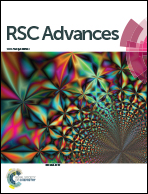Pd(ii) and Pt(ii) complexes of tridentate ligands with selective toxicity against Cryptococcus neoformans and Candida albicans†
Abstract
Novel Pd(II) and Pt(II) complexes of the tridentate 2,6-bis(1-ethyl-benzimidazol-2′-yl)pyridine (LBZ), and 4′-(2-pyridyl)-2,2′:6′,2′′-terpyridine (LPY) ligands were synthesized, characterized using a variety of analytical and spectroscopic tools, and screened for their potential antimicrobial properties against some bacterial and fungal strains as well as cytotoxicity against healthy human embryonic kidney (HEK293) cells. The electronic structures of the complexes were investigated by time-dependent density functional theory calculations. The free ligand LPY and benzimidazole complexes exhibited selective toxicity against Cryptococcus neoformans and Candida albicans, while displaying no cytotoxicity against HEK293. In the case of Cryptococcus neoformans, the antifungal activities of the benzimidazole-based complexes (MIC = 1.58–2.62 μM) are higher than those of the reference drug fluconazole (26.1 μM).



 Please wait while we load your content...
Please wait while we load your content...